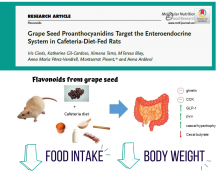Recently published paper regarding GSPE efects on the enteroendocrine system
Grape Seed Proanthocyanidins Target the Enteroendocrine System in Cafeteria-Diet-Fed Rats
Iris Ginés, Katherine Gil-Cardoso, Ximena Terra, MTeresa Blay, Anna Maria Pérez-Vendrell, Montserrat Pinent, and Anna Ardévol
Scope: The effects on the enteroendocrine system of three different grape seed proanthocyanidin extract (GSPE) treatments are analyzed in rats on a
cafeteria diet for 17 weeks.
Methods and results: GSPE is administered in a corrective manner (15 last days of the cafeteria diet) at two doses, 100 and 500 mg GSPE per kg bw. A
third, longer treatment in which GSPE (500 mg kg-1 bw) is administered daily every other week during the 17 weeks of the cafeteria diet is also tested. Most
GSPE treatments lead to ghrelin accumulation in the stomach, limited CCK secretion in the duodenum, and increased GLP-1 and PYY mRNA in colon. GSPE also increases cecal hypertrophy and reduces butyrate content. When the treatment is administered daily every other week during 17 weeks, there is also an increase in colon size. These effects are accompanied by a reduced food intake at the end of the experiment when GSPE is administered at 500 mg GSPE kg-1 during the last 15 days, but not on the other treatments, despite an observed reduction in body weight in the longer treatment.
Conclusion: GSPE modulates the enteroendocrine system in models in which it also reduces food intake or body weight.

